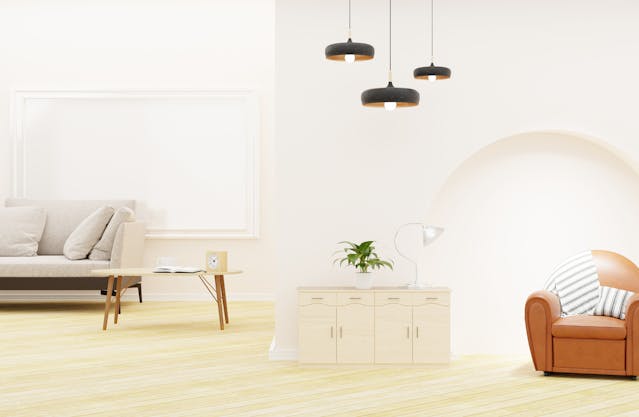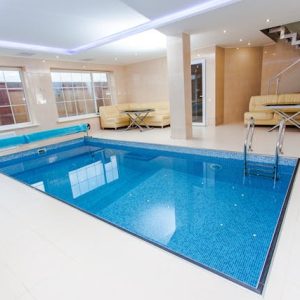A small living room can often feel claustrophobic and dark. However, it doesn’t have to be this way at all. Maximizing natural and artificial light can make it feel lighter and more airy. Effective use of light in living areas can significantly change how people perceive the size and feel of their surroundings, turning small spaces into bright, inviting settings. With the proper lighting, you can make your living space more functional and ambiance-filled. There are various methods for making the most of light in tiny spaces, such as window placement and choice, as well as interior design concepts that increase light and space. Continue reading as we discuss numerous tips for making the most of natural light in tiny spaces.
Maximizing Natural Light
In addition to its aesthetic value, natural light is essential for energy-efficient architecture, psychological stability, and physical health. It helps our circadian rhythms, which enhances mood and sleep patterns and lessens the need for artificial illumination, saving energy expenses. Here are effective ways to visually expand your area without tearing down walls, transforming tiny homes into luxurious spaces with many facilities.
- Strategic Mirror Placement
Placing mirrors appropriately to catch and reflect more light is a simple trick for natural light. A mirror’s reflective surface will aid in reflecting light, giving the space a sense of openness and brightness. For example, placing a mirror on the wall across from a small window in your bathroom can help reflect light and give the impression that the area is larger. You can use this technique in any room in your home; it’s a fantastic way to add lightness and airiness to a dimly lit area.
The natural light’s reach can double or even triple by mirrors and other reflective surfaces. Strategically placed mirrors can extend sunshine into practically every corner. Since the sun focuses on the west and east-facing walls for half of the day, mirrors, shiny metals, or reflective glass are placed on them for optimum effect. Observe the paths light beams take in your flat and install reflective surfaces there to capture and distribute light throughout the remaining areas of your house. Consult with a Northern Virginia rental property manager to propose light changes if you want to improve brightness in your home.
- Optimal Furniture Arrangement
Ensure adequate room for light to flow through your furniture arrangement. A small living space might appear much smaller and darker when overly cluttered. Get creative when improving your rental to make it feel like home. Maintain a clutter-free, orderly environment to let in as much natural light as possible. Furniture items such as readily movable nested tables or ottomans with storage are great for maximizing space and light. Remember to choose a low-profile piece of furniture and place it carefully to prevent windows from being blocked. This method guarantees unhindered light passage, adding to the feeling of openness and airiness.
- Choosing Light-Colored Paint
Although dark hues can create a warm, inviting atmosphere, they can also give off a narrow, claustrophobic vibe. Light-colored paint on the walls and ceiling can assist in reflecting light, giving the room a lighter, airier impression. Light hues can give an illusion of space and brightness since they reflect light. To make the most of the natural light in your living room, choose muted colors for your walls and furnishings, such as white, cream, or light gray.
Enhancing Artificial Lights
- Use of Layered Lighting
Layered lighting is a design approach that enhances artificial lighting by combining multiple light sources to create a functional and visually appealing environment. This approach uses three main layers which are the ambient, task, and accent lighting layers. The first layer, ambient lighting ensures visibility throughout the room because of the general illumination. The second layer, task lighting provides direct light for accuracy and clarity in specific areas where activities like reading or cooking occur. For the last layer, accent lighting helps improve the overall ambiance by highlighting architectural features or artwork and adding drama.
By carefully balancing these layers, it can create environments that can adapt to various functions and moods. Layered lighting allows energy efficiency and reduces eye strain by only using lights where and when needed. Layering lights ensure a harmonious blend of style and function in residential and commercial spaces, turning ordinary spaces into vibrant, well-lit environments.
- Strategic Light Fixtures
The strategic placement of artificial lighting can make a difference in establishing the tone of your space while adding functionality. It helps develop depth and atmosphere in the room by layering ambient, task, and accent lighting – that’s why investing in smart light fixtures can elevate any room. An example would be pendant lights over a kitchen island that provide lighting and a design focal point.
Accent lighting can add sophistication by highlighting architectural details or décor with LED strips placed behind mirrors or along shelves. Artificial lighting can subtly improve both functionality and style in a space by selecting fixtures that match the space’s intended use and aesthetic. Having well-organized lighting transforms a room, making it more aesthetically pleasing, welcoming, and functional.
- Avoid the Use of Heavy Fabrics
Homeowners should avoid using heavy fabrics in their space, such as thick rugs, curtains, or heavy upholstery, to maximize the impact of artificial lighting. Since these materials tend to absorb light, the space might appear smaller and more gloomy than it is. Choose linen, cotton, or sheer curtains to let in more natural light to make the space feel lighter.
Lighter fabric materials can help elevate the air and bring elegance at the same time. The room can be significantly improved by combining them with strategically placed artificial lighting, such as lamps or LED strips, ensuring the light is evenly distributed and aesthetically pleasing. Make the most of your lighting design and create a more spacious and inviting atmosphere in your home by steering clear of bulky fabrics.
Conclusion
Besides aesthetic values, maximizing light in small living areas is fundamental for a warm and healthy home environment. You can create the effect of having larger, more open space by strategic window placement, adding as many mirrors as possible, and then using light-colored paint on the walls to allow natural light into the room.
Supplementing artificial lighting with layered lights and using lighter fabrics can make any room bright. All these thought-out decisions can improve the atmosphere and create healthier health conditions. With all these tips, maximize the space size in your small living area and create an airy haven of comfort.




